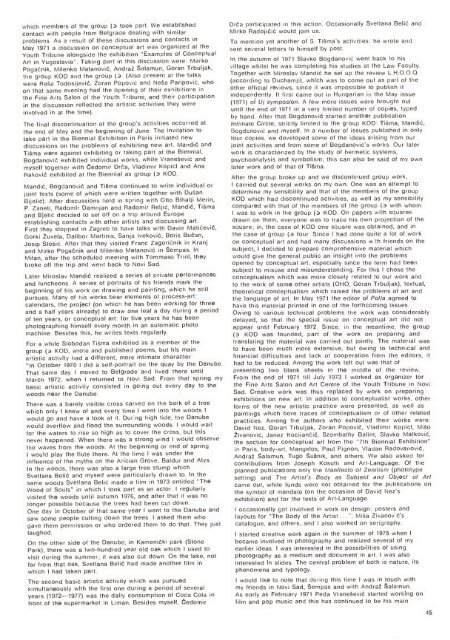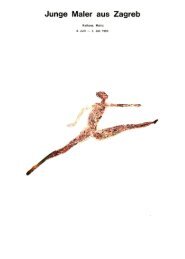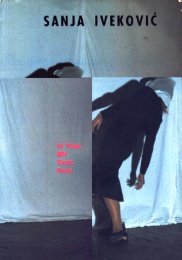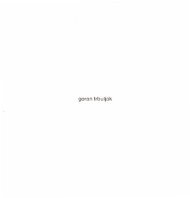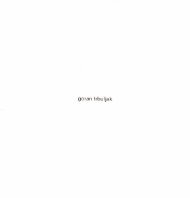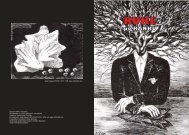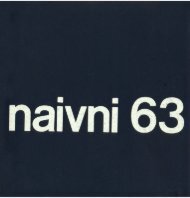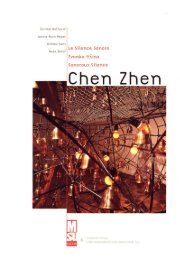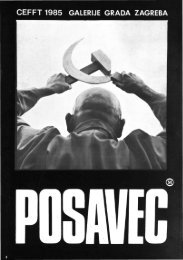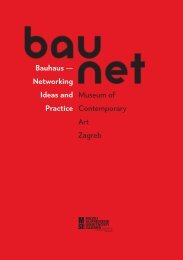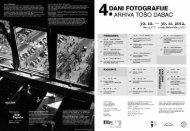The New Art Practice in Yugoslavia, 1966-1978
The New Art Practice in Yugoslavia, 1966-1978
The New Art Practice in Yugoslavia, 1966-1978
- TAGS
- practice
- yugoslavia
- www.msu.hr
Create successful ePaper yourself
Turn your PDF publications into a flip-book with our unique Google optimized e-Paper software.
which members of the group took part. We established<br />
contact with people from Belgrade deal<strong>in</strong>g with similar<br />
problems. As a result of these discussions and contacts <strong>in</strong><br />
May 1971 a discussion on conceptual art was organized at the<br />
Youth Tribune alongside the exhibition "Examples of Conceptual<br />
<strong>Art</strong> <strong>in</strong> <strong>Yugoslavia</strong>". Tak<strong>in</strong>g part <strong>in</strong> this discussion were: Marko<br />
Poganik, Milenko Matanovi, Andra alamun, Goran Trbuljak,<br />
the group KOD and the group (:). (Also present at the talks<br />
were Raa Todosijevi, Zoran Popovi and Nea Paripovi, who<br />
on that same even<strong>in</strong>g had the open<strong>in</strong>g of their exhibitions <strong>in</strong><br />
the F<strong>in</strong>e <strong>Art</strong>s Salon of the Youth Tribune, and their participation<br />
<strong>in</strong> the discussion reflected the artistic activities they were<br />
<strong>in</strong>volved <strong>in</strong> at the time).<br />
<strong>The</strong> f<strong>in</strong>al discont<strong>in</strong>uation of the group's activities occurred at<br />
the end of May and the beg<strong>in</strong>n<strong>in</strong>g of June. <strong>The</strong> <strong>in</strong>vitation to<br />
take part <strong>in</strong> the Biennial Exhibition <strong>in</strong> Paris <strong>in</strong>itiated new<br />
discussions on the problems of exhibit<strong>in</strong>g new art. Mandi and<br />
Tima were aga<strong>in</strong>st exhibit<strong>in</strong>g or tak<strong>in</strong>g part at the Biennial,<br />
Bogdanovi exhibited <strong>in</strong>dividual works, while Vraneevi and<br />
myself together with Cedomir Dra, Vladimir Kopicl and Ana<br />
Rakovi exhibited at the Biennial as group (3 KOD.<br />
Mandi, Bogdanovi and Tima cont<strong>in</strong>ued to write <strong>in</strong>dividual or<br />
jo<strong>in</strong>t texts (some of which were written together with Duan<br />
Bijeli). After discussions held <strong>in</strong> spr<strong>in</strong>g with Otto Bihalji Mer<strong>in</strong>,<br />
P. Zaneti, Radomir Damnjan and Radomir Relji, Mandi, Tima<br />
and Bjeli decided to set off on a trip around Europe<br />
establish<strong>in</strong>g contacts with other artists and discuss<strong>in</strong>g art.<br />
First they stopped <strong>in</strong> Zagreb to have talks with Davor Matievi,<br />
Gorki 2uvela, Dalibor Mart<strong>in</strong>is, Sanja Ivekovi, Boris Buan,<br />
Josip Stoi. After that they visited Franc Zagor<strong>in</strong>ik <strong>in</strong> Kranj<br />
and Mirko Poganik and Milenko Matanovi <strong>in</strong> empas. In<br />
Milan, after the scheduled meet<strong>in</strong>g with Tommaso Tr<strong>in</strong>i, they<br />
broke off the trip and went back to Novi Sad.<br />
Later Miroslav Mandi realized a series of private performances<br />
and luncheons. A series of portraits of his friends mark the<br />
beg<strong>in</strong>n<strong>in</strong>g of his work on draw<strong>in</strong>g and pa<strong>in</strong>t<strong>in</strong>g, which he still<br />
pursues. Many of his works bear elements of process-art:<br />
calendars, the project (on which he has been work<strong>in</strong>g for three<br />
and a half years already) to draw one leaf a day dur<strong>in</strong>g a period<br />
of ten years, or conceptual art: for five years he has been<br />
photograph<strong>in</strong>g himself every month <strong>in</strong> an automatic photo<br />
mach<strong>in</strong>e. Besides this, he writes texts regularly.<br />
For a while Slobodan Tima exhibited as a member of the<br />
group (a KOD, wrote and published poems, but his ma<strong>in</strong><br />
artistic activity had a different, more <strong>in</strong>timate character:<br />
"In October 1970 I did a self-portrait on the quay by the Danube.<br />
That same day I moved to Belgrade and lived there until<br />
March 1972, when I returned to Novi Sad. From that spr<strong>in</strong>g my<br />
basic artistic activity consisted <strong>in</strong> go<strong>in</strong>g out every day to the<br />
woods near the Danube.<br />
<strong>The</strong>re was a barely visible cross carved on the bark of a tree<br />
which only I knew of and every time I went <strong>in</strong>to the woods I<br />
would go and have a look at it. Our ng high tide, the Danube<br />
would overflow and flood the surround<strong>in</strong>g woods. I would wait<br />
for the waters to rise so high as to cover the cross, but this<br />
never happened. When there was a strong w<strong>in</strong>d I would observe<br />
the waves from the woods. At the beg<strong>in</strong>n<strong>in</strong>g or end of spr<strong>in</strong>g<br />
I would play the flute there. At the time I was under the<br />
<strong>in</strong>fluence of the myths on the Arician Grove, Baldur and Atys.<br />
In the woods, there was also a large tree stump which<br />
Svetlana Beli and myself were particularly drawn to. In the<br />
same woods Svetlana Beli made a film <strong>in</strong> 1973 entitled "<strong>The</strong><br />
Wood of Souls" <strong>in</strong> which I took part as an actor. I regularly<br />
visited the woods until autumn 1976, and after that it was no<br />
longer possible because the trees had been cut down.<br />
One day <strong>in</strong> October of that same year I went to the Danube and<br />
saw some people cutt<strong>in</strong>g down the trees. I asked them who<br />
gave them permission or who ordered them to do that. <strong>The</strong>y just<br />
laughed.<br />
On the other side of the Danube, <strong>in</strong> Kameniki park (Stone<br />
Park), there was a two-hundred year old oak which I used to<br />
visit dur<strong>in</strong>g the summer; it was also cut down On the lake, not<br />
far from that oak, Svetlana Beli had made another film <strong>in</strong><br />
which I had taken part.<br />
<strong>The</strong> second basic artistic activity which was pursued<br />
simultaneously with the first one dur<strong>in</strong>g a period of several<br />
years (1972-1977) was the daily consumption of Coca Cola <strong>in</strong><br />
front of the supermarket <strong>in</strong> Liman. Besides myself, Cedomir<br />
Dra participated <strong>in</strong> this action. Occasionally Svetlana Beli and<br />
Mirko Radojii would jo<strong>in</strong> us.<br />
To mention yet another of S. Tima's activities: he wrote and<br />
sent several letters to himself by post.<br />
In the autumn of 1971 Slavko Bogdanovi went back to his<br />
village whilst he was complet<strong>in</strong>g his studies at the Law Faculty.<br />
Together with Miroslav Mandi he set up the review L.H.O.O.Q.<br />
(accord<strong>in</strong>g to Duchamp), which was to come out as part of the<br />
other official reviews, s<strong>in</strong>ce it was impossible to publish it<br />
<strong>in</strong>dependently. It first came out <strong>in</strong> Hungarian <strong>in</strong> the May issue<br />
(1971) of Uj sympos;on. A few more issues were brought out<br />
until the end of 1971 <strong>in</strong> a very limited number of copies, typed<br />
by hand. After that Bogdanovi started another publication<br />
Intimate Circle, strictly limited to the group KOD: Tima, Mandi,<br />
Bogdanovi and myself. In a number of issues published <strong>in</strong> only<br />
four copies. we developed some of the ideas aris<strong>in</strong>g from our<br />
jo<strong>in</strong>t activities and from some of Bogdanovi's works. Our later<br />
work is characterized by the study of hermetic systems,<br />
psychoanalysis and symbolism; this can also be said of my own<br />
later work and of that of Tima.<br />
After the group broke up and we discont<strong>in</strong>ued group work,<br />
I carried out several works on my own. One was an attempt to<br />
determ<strong>in</strong>e my sensibility and that of the members of the group<br />
KOD which had discont<strong>in</strong>ued activities, as well as my sensibility<br />
compared with that of the members of the group (3 with whom<br />
I was to work <strong>in</strong> the group Ci KOD. On papers with squares<br />
drawn on them, everyone was to trace his own projection of the<br />
square; <strong>in</strong>, the case of KOD one square was obta<strong>in</strong>ed, and <strong>in</strong><br />
had done quite a lot of work<br />
the case of group (a four. S<strong>in</strong>ce I<br />
on conceptual art and had many discussions w.th friends on the<br />
subject, I decided to prepare comprehensive material which<br />
would give the general public an <strong>in</strong>sight <strong>in</strong>to the problems<br />
opened by conceptual art, especially s<strong>in</strong>ce the term had been<br />
subject to misuse and misunderstand<strong>in</strong>g. For this I chose the<br />
conceptualism which was more closely related to our work and<br />
to the work of some other artists (OHO, Goran Trbuljak), textual,<br />
theoretical conceptualism which raised the problems of art and<br />
the language of art. In May 1971 the editor of Polja agreed to<br />
have this material pr<strong>in</strong>ted <strong>in</strong> one of the forthcom<strong>in</strong>g issues.<br />
Ow<strong>in</strong>g to various technical problems the work was considerably<br />
delayed, so that the special issue on conceptual art did not<br />
appear until February 1972. S<strong>in</strong>ce, <strong>in</strong> the meantime, the group<br />
KOD was founded, part of the work on prepar<strong>in</strong>g and<br />
translat<strong>in</strong>g the material was carried out jo<strong>in</strong>tly. <strong>The</strong> material was<br />
to have been much more extensive, but ow<strong>in</strong>g to technical and<br />
f<strong>in</strong>ancial difficulties and lack of cooperation from the editors, it<br />
had to be reduced. Among the work left out was that of<br />
present<strong>in</strong>g two blank sheets <strong>in</strong> the middle of the review.<br />
From the end of 1971 till July 1973 I worked as organizer for<br />
the F<strong>in</strong>e <strong>Art</strong>s Salon and <strong>Art</strong> Centre of the Youth Tribune <strong>in</strong> Novi<br />
Sad. Creative work was thus replaced by work on prepar<strong>in</strong>g<br />
exhibitions on new art. In addition to conceptualist works, other<br />
forms of the new artistic practice were presented, as well as<br />
pa<strong>in</strong>t<strong>in</strong>gs which bore traces of conceptualism or of other related<br />
practices. Among the authors who exhibited their works were:<br />
David Nez, Goran Trbuljak, Zoran Popovi, Vladimir Kopicl, Mio<br />
2ivanovi, Janez Kocijani, Szombathy Bal<strong>in</strong>t, Slavko Matkovi,<br />
the section for conceptual art from the "7th Biennial Exhibition"<br />
<strong>in</strong> Paris, body-art. Mangelos, Paul Pignon, Vladan Radovanovi,<br />
Andra alamun, Tugo unik, and others. We also asked for<br />
contributions from Joseph Kosuth and <strong>Art</strong>-Language. Of the<br />
planned publications only the Manifesto of Zenitism (phototype<br />
sett<strong>in</strong>g) and <strong>The</strong> <strong>Art</strong>ist's Body as Subject and Object of <strong>Art</strong><br />
came out, while funds were not obta<strong>in</strong>ed for the publications on<br />
the symbol of mandala (on the occasion of David Nez's<br />
exhibition) and for the texts of <strong>Art</strong>-Language.<br />
I occasionally got <strong>in</strong>volved <strong>in</strong> work on design: posters and<br />
layouts for "<strong>The</strong> Body of the <strong>Art</strong>ist ...". Mia 2ivanov''s<br />
catalogue, and others, and I also worked on serigraphy.<br />
I started creative work aga<strong>in</strong> <strong>in</strong> the summer of 1975 when I<br />
became <strong>in</strong>volved <strong>in</strong> photography and realized several of my<br />
earlier ideas. I was <strong>in</strong>terested <strong>in</strong> the possibilities of us<strong>in</strong>g<br />
photography as a medium and document <strong>in</strong> art. I was also<br />
<strong>in</strong>terested <strong>in</strong> slides. <strong>The</strong> central problem of both is nature, its<br />
phenomena and typology.<br />
I would like to note that dur<strong>in</strong>g this time I was <strong>in</strong> touch with<br />
my friends <strong>in</strong> Novi Sad, empas and with Andra alamun.<br />
As early as February 1971 Peda Vraneevi started work<strong>in</strong>g on<br />
film and pop music and this has cont<strong>in</strong>ued to be his ma<strong>in</strong><br />
45


